人教版高一英语必修二 Unit 1 Cultural relics reading 课件(共28张PPT)
文档属性
| 名称 | 人教版高一英语必修二 Unit 1 Cultural relics reading 课件(共28张PPT) | 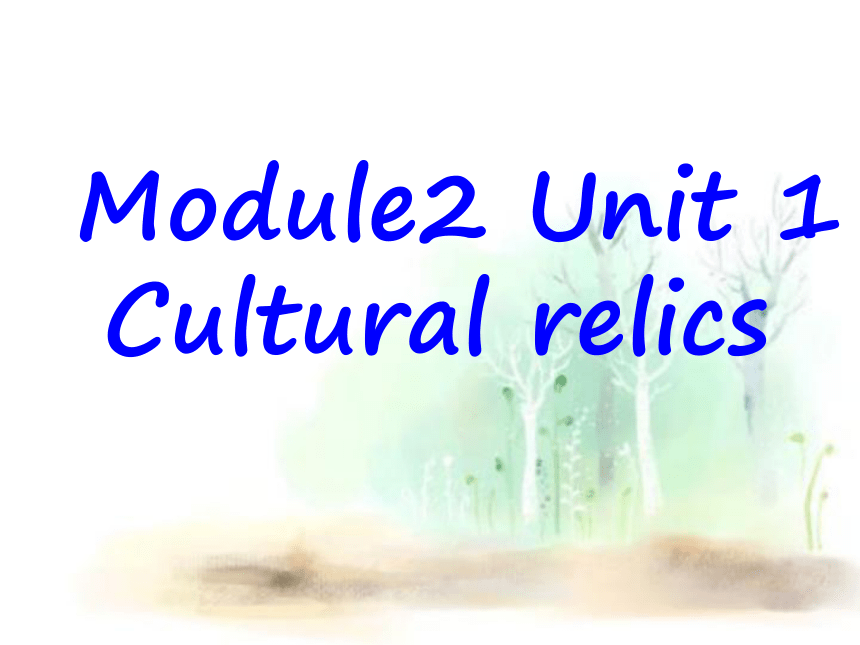 | |
| 格式 | pptx | ||
| 文件大小 | 2.0MB | ||
| 资源类型 | 教案 | ||
| 版本资源 | 人教版(新课程标准) | ||
| 科目 | 英语 | ||
| 更新时间 | 2021-02-16 18:58:09 | ||
图片预览

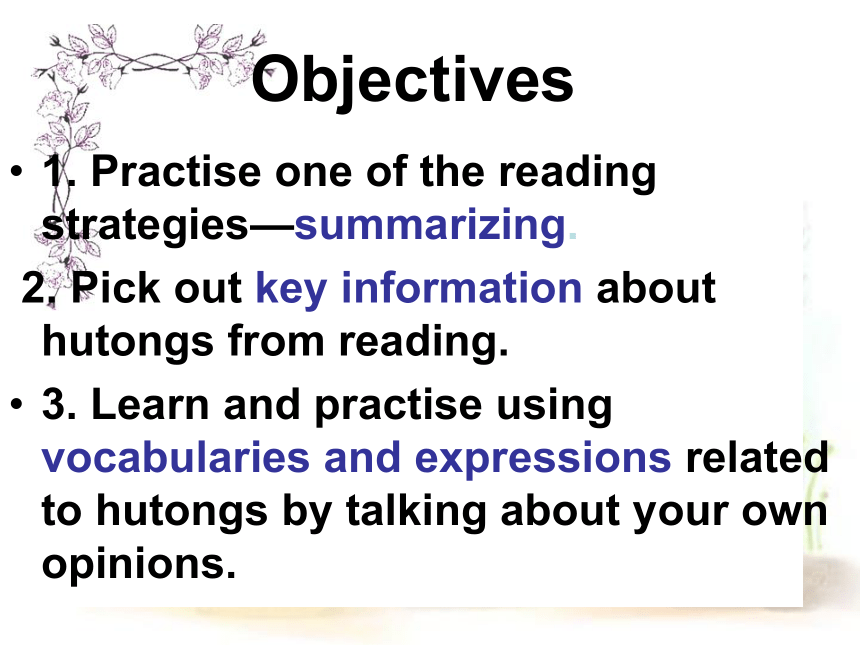
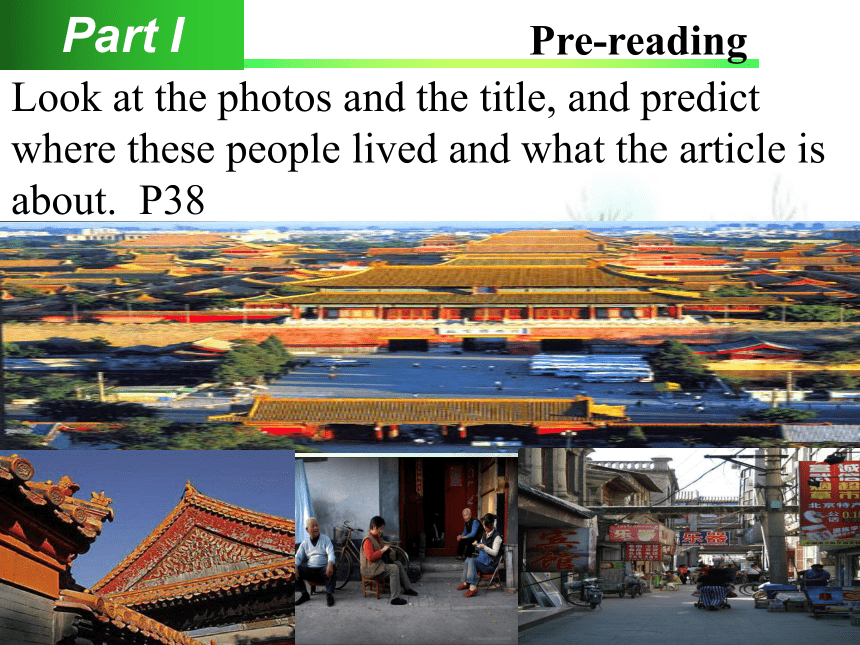

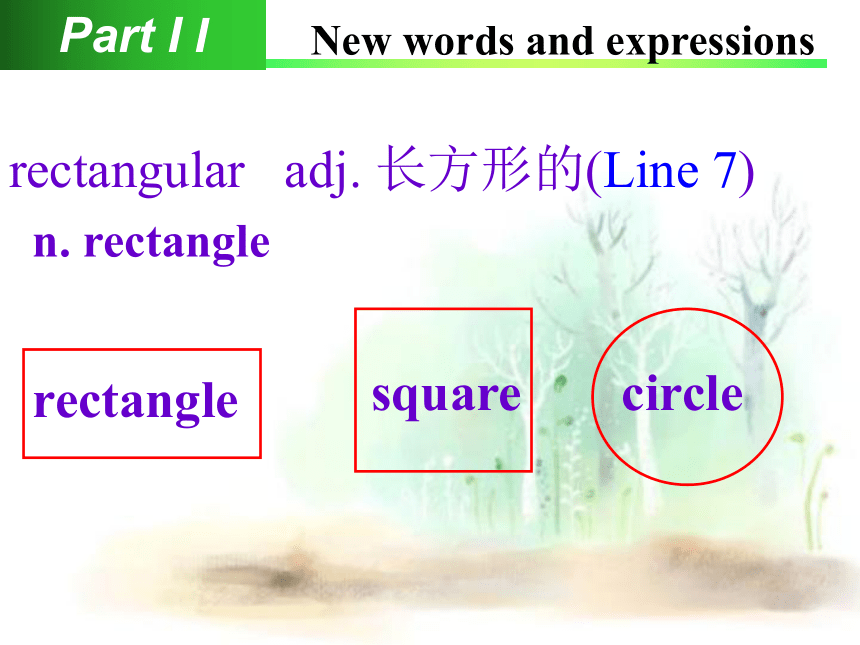
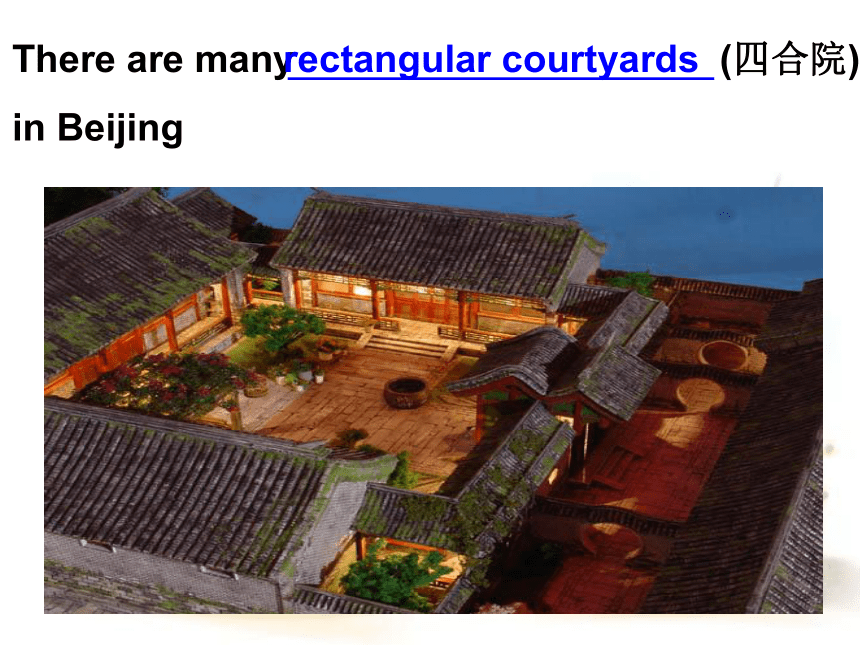
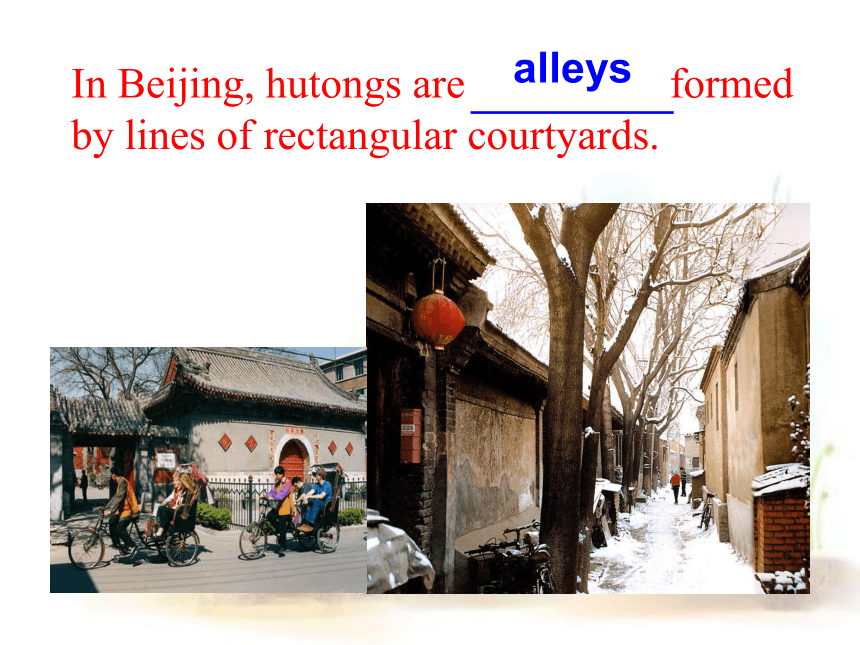
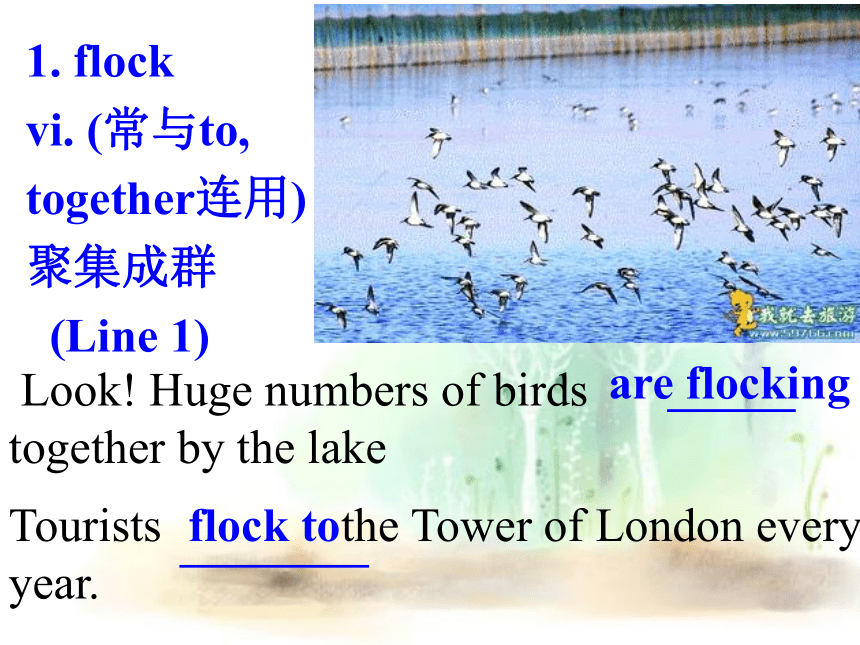
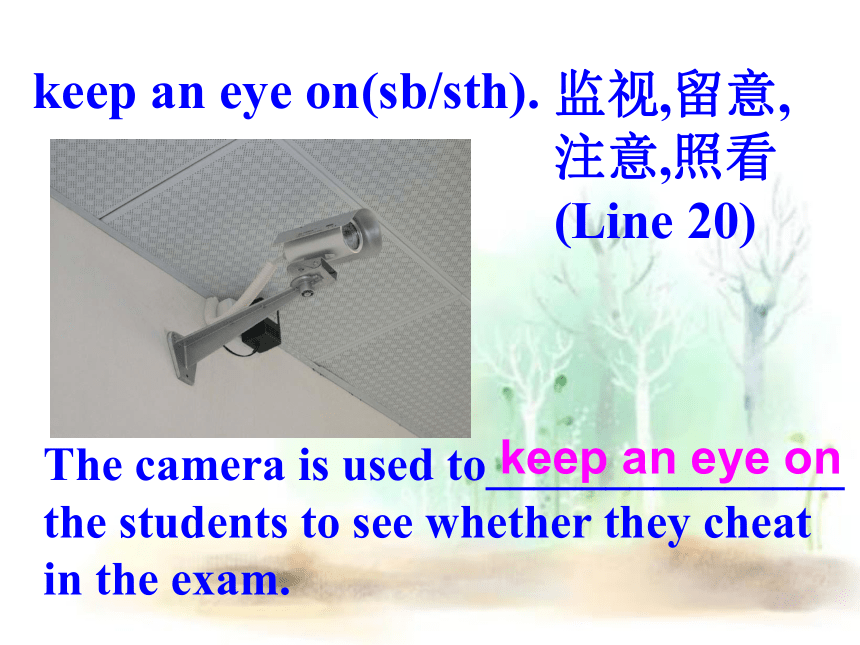
文档简介
Module2 Unit 1
Cultural relics
Objectives
1. Practise one of the reading strategies—summarizing.
2. Pick out key information about hutongs from reading.
3. Learn and practise using vocabularies and expressions related to hutongs by talking about your own opinions.
Part I
Pre-reading
Look at the photos and the title, and predict where these people lived and what the article is about. P38
2.Choose the best title for the article from the list below.
a、Beijing Urban Planning
b、Chinese Buildings
c、Beijing’s Hutongs
d、The History of Hutongs
rectangular adj. 长方形的(Line 7)
n. rectangle
rectangle
square
circle
Part I I
New words and expressions
There are many (四合院)
in Beijing
rectangular courtyards
In Beijing, hutongs are formed by lines of rectangular courtyards.
alleys
1. flock
vi. (常与to,
together连用)
聚集成群
(Line 1)
Look! Huge numbers of birds together by the lake
are flocking
Tourists the Tower of London every
year.
flock to
keep an eye on(sb/sth).
The camera is used to_______________
the students to see whether they cheat
in the exam.
keep an eye on
监视,留意,
注意,照看
(Line 20)
Reading strategies:
Summarising
Read the text to get the general idea and identify paragraph topics.
Underline the key sentence in each paragraph (often at the beginning or at the end of a paragraph, but not always).
Skimming
However/But
Not only…but also
Although/though
1.it is/was…that
2.to do/in order to
Task1.Match the headings to the correct paragraphs
1.Bad times for hutongs
2.When and why hutongs were built
3.Beijing’s hutongs today
4.What is hutong?
5.Connecting lives
A
B
C
D
E
Part IV
Organisation
Fill in the blanks with the information from the text.
Paragraph 1:
Details:
Originally, the hutong refers to the (1) _____________ connecting the courtyards of traditional houses.
Now the “hutong” also refers to the (2) ___________ and even to the communities that live there.
little alleys
courtyards
Detailed-- reading
Paragraph 2:
Details:
Most hutongs in Beijing were built between (3)_________________________.
Hutongs made it easy for the rulers to (4) _______________.
Paragraph 3:
Details:
Hutongs connect people’s homes as well as (5)__________. People living in hutongs share their (6)__________________.
the 13th and 19th centuries
control the city
their lives
joy and sadness
Paragraph 4:
Details:
Towards______________________, the conditions in Beijing’s hutongs went down. (8) _________________ came when the People’s Republic of China was founded.
the end of the Qing Dynasty
The turning point
Paragraph 5:
Hutongs are still an (9)____________ of Beijing life.
The hutongs not only connect Beijing’s streets and communities, but also its (10) ________________.
important part
past and present
Detailed-- reading
Read the text carefully and finish the following exercises.
History
Most of Beijing’s hutongs were built during the ________, ________ and ________ Dynasties to help the Emperors keep control over the city.
Lives of people
People living in courtyards share_______,borrow ________ and burning ________ ________ together. Hutongs connected people’s lives.
Famous hutongs
Sanmiao Street
It dates back ________ years ago.
_______
Hutong
The ________ hutong at 2km
_______ Hutong
Tourists can squeeze through it
-- the hutong at only 40cm wide
recipes
mops
fragrant
incense
900
Rongxian
longest
Qianshi
Yuan
Qing
narrowest
Changes in the functions of Beijing’s hutongs
(famous tourist attractions)
Ming
1.What does hutong refer to at different times?
3) Alleys, courtyards, the communities that live there
Changes in the meanings of hutongs
In the
past
nowadays
1) The alleys that connect the courtyards
2) The courtyards themselves
2. Were Beijing’s hutongs in good conditions in the past? Why?
No, they weren’t.
1). Towards the end of the Qing Dynasty, the conditions in Beijing’s hutongs went down. Many new hutongs were poorly made.
2). When the People’s Republic of China was set up, conditions improved a lot.The government preserved many of the oldest hutongs.
Changes in the conditions of Beijing’s hutongs
In the
past
nowadays
How about the future of Beijing’s hutongs?
The history of
Beijing’s hutongs
The present of
Beijing’s hutongs
People are having a discussion about whether_ Beijing’s hutongs should be pulled down. Opinions are divided on this issue. What’s your opinion?
Post-- reading
Discussion
There is no consensus of opinions among people about.....(争论焦点).Some people are of the view that...(观点一),while others take an opposite side, firmly believe that...(观点二).
As far as I am concerned, the former (latter) notion is preferable in many senses. The reasons are obvious. First of all,...(论据一).Furthermore,...(论据二)Among all of the supporting evidences , one is the strongest. That is,....(论据三).
A natural conclusion from the above discussion is that...(总结观点).As students, we are supposed to......(支持某种观点)
Post-- reading
北京有很多胡同,有些胡同已经老化,对是否应该花巨资来维护和保护这些胡同文化,网友展开了热烈的讨论,不同人持不同态度,那么你的观点呢?
赞成的原因
2. 反对的原因
拆毁 pull down/tear down
Discussion
Summary
Lead-in
1
3
Careful reading
4
Speaking
5
Fast reading
2
Word study
Conclusion
6
Homework
2.Retell the text to each other using the notes from the text,
trying to use your own words.
1.Finish exercise 9 on P39.
There are many historical hutongs in China,some of which are in bad conditions.How about their tomorrow is it? Majority of people think it's important to protect them. They are important to attract foreign travellers to come and promote the development of economy. Minority of people think they are too old. It will cost too much money and time to maintain them. Besides that, they occupy too much room and they should be pulled down. However, I think it's definitely important to protect them. Although they are old, once you tear them down you can never rebuilt them. They are the sign and monument of ancient Chinese culture.
Conclusion
Over centuries, they changed so much. But they still exist in a new look now.
经过了几个世纪,它们改变了很多。如今,它们仍然以一种全新面貌存在着。它们是中国古代建筑的代表。不管如何改变,都应该被当做国家的宝贵财富而保存下来。
They are features of China’s ancient architecture.
No matter how they change, they should be preserved as treasures of China.
Cultural relics
Objectives
1. Practise one of the reading strategies—summarizing.
2. Pick out key information about hutongs from reading.
3. Learn and practise using vocabularies and expressions related to hutongs by talking about your own opinions.
Part I
Pre-reading
Look at the photos and the title, and predict where these people lived and what the article is about. P38
2.Choose the best title for the article from the list below.
a、Beijing Urban Planning
b、Chinese Buildings
c、Beijing’s Hutongs
d、The History of Hutongs
rectangular adj. 长方形的(Line 7)
n. rectangle
rectangle
square
circle
Part I I
New words and expressions
There are many (四合院)
in Beijing
rectangular courtyards
In Beijing, hutongs are formed by lines of rectangular courtyards.
alleys
1. flock
vi. (常与to,
together连用)
聚集成群
(Line 1)
Look! Huge numbers of birds together by the lake
are flocking
Tourists the Tower of London every
year.
flock to
keep an eye on(sb/sth).
The camera is used to_______________
the students to see whether they cheat
in the exam.
keep an eye on
监视,留意,
注意,照看
(Line 20)
Reading strategies:
Summarising
Read the text to get the general idea and identify paragraph topics.
Underline the key sentence in each paragraph (often at the beginning or at the end of a paragraph, but not always).
Skimming
However/But
Not only…but also
Although/though
1.it is/was…that
2.to do/in order to
Task1.Match the headings to the correct paragraphs
1.Bad times for hutongs
2.When and why hutongs were built
3.Beijing’s hutongs today
4.What is hutong?
5.Connecting lives
A
B
C
D
E
Part IV
Organisation
Fill in the blanks with the information from the text.
Paragraph 1:
Details:
Originally, the hutong refers to the (1) _____________ connecting the courtyards of traditional houses.
Now the “hutong” also refers to the (2) ___________ and even to the communities that live there.
little alleys
courtyards
Detailed-- reading
Paragraph 2:
Details:
Most hutongs in Beijing were built between (3)_________________________.
Hutongs made it easy for the rulers to (4) _______________.
Paragraph 3:
Details:
Hutongs connect people’s homes as well as (5)__________. People living in hutongs share their (6)__________________.
the 13th and 19th centuries
control the city
their lives
joy and sadness
Paragraph 4:
Details:
Towards______________________, the conditions in Beijing’s hutongs went down. (8) _________________ came when the People’s Republic of China was founded.
the end of the Qing Dynasty
The turning point
Paragraph 5:
Hutongs are still an (9)____________ of Beijing life.
The hutongs not only connect Beijing’s streets and communities, but also its (10) ________________.
important part
past and present
Detailed-- reading
Read the text carefully and finish the following exercises.
History
Most of Beijing’s hutongs were built during the ________, ________ and ________ Dynasties to help the Emperors keep control over the city.
Lives of people
People living in courtyards share_______,borrow ________ and burning ________ ________ together. Hutongs connected people’s lives.
Famous hutongs
Sanmiao Street
It dates back ________ years ago.
_______
Hutong
The ________ hutong at 2km
_______ Hutong
Tourists can squeeze through it
-- the hutong at only 40cm wide
recipes
mops
fragrant
incense
900
Rongxian
longest
Qianshi
Yuan
Qing
narrowest
Changes in the functions of Beijing’s hutongs
(famous tourist attractions)
Ming
1.What does hutong refer to at different times?
3) Alleys, courtyards, the communities that live there
Changes in the meanings of hutongs
In the
past
nowadays
1) The alleys that connect the courtyards
2) The courtyards themselves
2. Were Beijing’s hutongs in good conditions in the past? Why?
No, they weren’t.
1). Towards the end of the Qing Dynasty, the conditions in Beijing’s hutongs went down. Many new hutongs were poorly made.
2). When the People’s Republic of China was set up, conditions improved a lot.The government preserved many of the oldest hutongs.
Changes in the conditions of Beijing’s hutongs
In the
past
nowadays
How about the future of Beijing’s hutongs?
The history of
Beijing’s hutongs
The present of
Beijing’s hutongs
People are having a discussion about whether_ Beijing’s hutongs should be pulled down. Opinions are divided on this issue. What’s your opinion?
Post-- reading
Discussion
There is no consensus of opinions among people about.....(争论焦点).Some people are of the view that...(观点一),while others take an opposite side, firmly believe that...(观点二).
As far as I am concerned, the former (latter) notion is preferable in many senses. The reasons are obvious. First of all,...(论据一).Furthermore,...(论据二)Among all of the supporting evidences , one is the strongest. That is,....(论据三).
A natural conclusion from the above discussion is that...(总结观点).As students, we are supposed to......(支持某种观点)
Post-- reading
北京有很多胡同,有些胡同已经老化,对是否应该花巨资来维护和保护这些胡同文化,网友展开了热烈的讨论,不同人持不同态度,那么你的观点呢?
赞成的原因
2. 反对的原因
拆毁 pull down/tear down
Discussion
Summary
Lead-in
1
3
Careful reading
4
Speaking
5
Fast reading
2
Word study
Conclusion
6
Homework
2.Retell the text to each other using the notes from the text,
trying to use your own words.
1.Finish exercise 9 on P39.
There are many historical hutongs in China,some of which are in bad conditions.How about their tomorrow is it? Majority of people think it's important to protect them. They are important to attract foreign travellers to come and promote the development of economy. Minority of people think they are too old. It will cost too much money and time to maintain them. Besides that, they occupy too much room and they should be pulled down. However, I think it's definitely important to protect them. Although they are old, once you tear them down you can never rebuilt them. They are the sign and monument of ancient Chinese culture.
Conclusion
Over centuries, they changed so much. But they still exist in a new look now.
经过了几个世纪,它们改变了很多。如今,它们仍然以一种全新面貌存在着。它们是中国古代建筑的代表。不管如何改变,都应该被当做国家的宝贵财富而保存下来。
They are features of China’s ancient architecture.
No matter how they change, they should be preserved as treasures of China.
